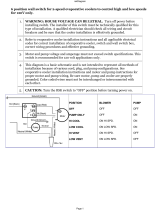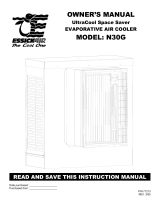
7
110496-1
WC46, N46W
RWC46, RN46W
No. RWC35, WC37, WC44, WC50, N50W
N° Description / Descripción RN35W N37W N44W RWC50, RN50W
1. Top Pan / Tapa ........................................................................................................................ 222175-021 222175-021 222905-001 220901-003
2. Bottom Pan / Base De La Caja ..............................................................................................222175-002 222175-002 222903-006 220902-002
3. Louvered Side Assembly / Montaje De Reja Lateral ............................................................324006-107 (2) 324006-107 (2) 324006-106 (2) 324007-205 (3)
4. Water Trough, Side / Canal De Agua, Lateral .......................................................................226004-001 (2) 226004-001 (2) 226003-001 (2) 226003-002 (3)
5. Aspen Pads, Side / Filtros De Paja, Lateral ..........................................................................110084 (2) 110084 (2) 110094 (2) 110098 (3)
6. Pad Retainer, Side / Soporte Para El Filtro, Lateral .............................................................3PW-16 (6) 3PW-16 (6) 3PW-3 (6) 3PW-5 (9)
7. Louvered Back Assembly / Montaje De Reja Posterior ........................................................324006-108 324006-108 324007-205 See/Vea #3
8. Water Trough, Back / Canal De Agua, Posterior ...................................................................226004-002 226004-002 226003-002
9. Aspen Pads, Back / Filtros De Paja, Posterior ......................................................................110083 110083 110098
10. Pad Retainer, Back / Soporte Para El Filtro, Posterior .........................................................3PW-15 3PW-15 3PW-5 (3)
11. Corner Post / Poste De Esquina .............................................................................................324018-003 (2) 324018-003 (2) 324003-057 (2) 324003-057 (2)
13. Front Panel / Panel Delantero ................................................................................................224175-001 224175-001 224103-006 224105-004
14. Tunnel / Túnel (Cuello Del Enfriador) ...................................................................................322120-001 322120-001 322120-001 322120-001
15. Blower Housing / Caja De La Rueda .....................................................................................324175-005 324175-005 324103-007 324105-006
16. Blower Wheel / Rueda ...........................................................................................................110765 110765 15BW 16BW
17. Shaft, Blower Wheel / Eje De La Rueda ................................................................................110179 110179 110182 110183
18. Bearings, Blower Wheel Shaft / Cojinetes Del Eje De La Rueda ..........................................110351-001 (2) 110351-001 (2) 110351 (2) 110351 (2)
19. Pulley, Blower Wheel / Polea De La Rueda ..........................................................................110270 110270 110275 110275
20. Drive Belt / Correa .................................................................................................................110226 110226 110215 110215
21. Motor / Motor .........................................................................................................................110445* 110445* 110445* *
22. Pulley, Motor / Polea Del Motor ............................................................................................110271 110271 110272 *
23. Motor Mount / Montura Del Motor .......................................................................................314003-026 314003-026 314003-025 314003-024
24. Motor Mount Clips / Seguros Para Montar Motor ................................................................314005-001 314005-001 314005-001 314005-001
25. Float Valve / Válvula Del Flotador ........................................................................................FL-C FL-C FL-C FL-C
26. Pump Mount / Montura De La Bomba ...................................................................................218001-032 218001-032 218001-031 218001-031
28. Pump / Bomba ........................................................................................................................110428 110428 110428 *
29. Pump Retainer
/ Sujetador De La Bomba ..............................................................................110714 110714 110714 110714
31. Tube, Water Delivery / Tubo De Agua ...................................................................................310716 310716 310716 310716
33. Water Distributor Assembly / Sistema Del Distribuidor De Agua .........................................3D-15 3D-15 3D-3 3D-10
34. Holder, Water Distributor / Soporte Para El Distribuidor De Agua ......................................110574 (3) 110574 (3) 110574 (3) 110574 (6)
35. Over Flow Assembly / Montaje De Desagüe .........................................................................3OA-1 3OA-1 3OA-1 3OA-1
36. House Leg Collar Assembly / Montaje De Collar De La Pata ..............................................3HL-3 (2) 3HL-3 (2) 3HL-1 (2) 3HL-1 (2)
37. House Leg / Pata .................................................................................................................... 310811 (2) 310811 (2) 310811 (2) 310811 (2)
38. Retainers, Window Panels / Guarda De Retención Para Los Paneles ..................................110599 (4) 110599 (4) 110599 (4) 110599 (4)
39. Window Panels / Paneles De Relleno Para La Ventana ........................................................110603 (2) 110603 (2) 110603 (2) 110603 (2)
40. †Electrical Cord, Motor / Cable Eléctrico Del Motor ........................................................... 110372† 110372 110372†
41. †Wiring Harness / Cableado Eléctrico................................................................................... 110375† 110375 110375†
42. †Switch / Interruptor .............................................................................................................. 110425† 110425 110425†
43. †Knob, Switch / Perilla Del Interruptor ................................................................................ 110839-006† 110839-006 110839-006†
44. †Switch Box / Caja Para El Interruptor .................................................................................. 222006-001† 222006-001 222006-001†
45. †Lockplate, Manual Units / Placa De fi jación, Unidades De Control Manual ...................... 222007-001† 222007-001 222007-001†
46. †Grill Assembly, Manual Units / Rejilla Completa, Control Manual .................................... 110839-1† 110839-1 110839-1†
46a. ‡Grill Assembly, Remote Units / Rejilla Completa, Control A Distancia .............................110839-2‡ - - 110839-2‡
47.
‡Lockplate & Grommet, Remote Units / Placa De fi jación Con Pasahilo, Control A Distancia ..............322007-004‡ - - 322007-004‡
48. ‡Electronic Control Assembly / Montaje De Control Electrónico .........................................110400‡ - - 110400‡
49. ‡Dress Ring / Anillo Decorativo .............................................................................................110403‡ - - 110403‡
50. ‡Remote Control / Mando A Distancia ...................................................................................110401-1‡ - - 110401-1‡
51. **Grill Cover / Cubierta Para La Rejilla ..............................................................................110829** 110829** 110829** 110829**
52. **Bleed-Off Kit / Equipo De La Válvula De Desahogo ........................................................310586** 310586** 310586** 310586**
53. §Mount Strips For Vertical Tunnel / Tiras De Metal Para El Conducto Vertical ................370804§ 370804§ 322008-001§ 322008-001§
* See motor specifi cation table. / Vea la tabla de especifi caciones del motor.
** Optional accessories. Must be purchased separately. / Accesorios opcionales. Debe comprarlos por separados.
† For Manual Control units. / Para las unidades de control manual .
‡ For Remote Control units. / Para las unidades de control a distancia.
§ Not included with unit. Call 1-800-643-8341 to obtain this part at no additional cost. / No incluido con la unidad. Llame 1-800-643-8341 para obtener esta parte
sin coste adicional.
NOTE: Standard hardware items may be purchased from your local hardware store.
NOTA: Artículos de uso corriente pueden comprarse en la ferretería de su localidad.
Replacement Parts List / Lista De Piezas De Repuesto
When ordering parts, please be sure to furnish the following information on all orders. Failure to do so may delay your order. /
Al pedir piezas, incluya toda la información siguiente con su pedido. El no proporcionar toda esta información resultará en una demora.
1. Cooler Model No. / Modelo de la unidad
2. Cooler serial number / Número de serie de la unidad
3. Description and part number / Descripción y número de pieza
4. Date of purchase / Fecha de compra





















